|
Having trouble reading this email?
Download the PDF.

Thematic Focus: Climate Change, Ecosystem Management
Measuring Glacier Change in the Himalayas
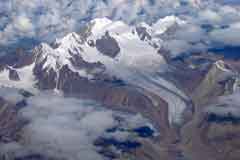
A serious lack of reliable and consistent data severely hampers scientific knowledge about the state of Himalayan glaciers.
As a result, the contribution of glacial melt to the Himalayan river basins remains uncertain. This is of grave importance because
declining water availability could threaten the food security of more than 70 million people. There is thus an urgent need to
improve cross-boundary scientific collaboration and monitoring of glaciers to bridge the knowledge gap and allow policy options
to be based on appropriate scientific evidence.
Why is This Issue Important?
Seasonal meltwater from the Himalayan glaciers is one of the main sources of freshwater reserves that directly
sustain people living in the region, especially in arid and semi-arid areas. At varying degrees and times, about 1.3 billion
people living in the Himalayan river basins rely on both meltwater and monsoon waters to sustain their livelihoods, mainly
for irrigation, drinking, sanitation and industrial uses (9, 46, 33). Net irrigation-water demand is high in this region
(Table 1), but per capita water availability is very low—around 2 000 to 3 000 m3/capita/year—which is far less than
the world average of 8 549 m3/capita/year) (38).
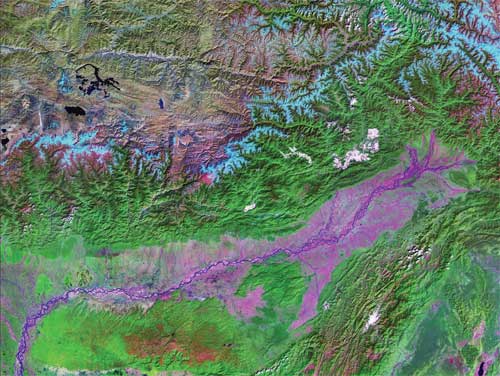
Figure 1: Landsat image showing glaciers of the Himalaya Mountain
Range (light blue) and the sediment-choked and braided valley of the Brahmaputra River (purple) of Eastern India.
High Resolution Image - 862KB (GN 2007).
Full Size Image
Based on a projected estimate of glacier area in 2050, it is thought
that declining water availability will eventually threaten some 70 million people with food insecurity (Table 1) (17).
The Hindu-Kush Himalayan region, including the Tibetan plateau, also functions as a complex interaction of "atmospheric, cryospheric,
hydrological, geological and environmental processes that bear special significance for the Earth's biodiversity, climate and water
cycles" (48). For example, the region plays a prominent role in generating the Asian monsoon system that sustains one of the largest
populations on earth (5). These ecosystem services from the Himalayan river basins also form the basis for a substantial
portion of the region's total Gross Domestic Product (GDP) (9).

Table 1: Based on a best guess of glacier area in 2050,
this projection shows the number of people in the Himalayan area who could be threatened by food insecurity due to changes
in the Himalayan glaciers. Increased mean upstream rainfall partly compensates for upstream water losses, although net
irrigation demand may put more stress on the region's food security. The Yellow River basin, where there is an increase in
upstream water yield, is an exception. The Yellow River basin only marginally depends on glacial melt; thus there is a notable
9.5 per cent increase in upstream water yield in the basin with an estimate of an increase of 3.0±0.6 million people that
can be fed in the Yellow River basin. Upstream refers to the area above 2,000 m altitude. (17). * upper Indus
Full Size Image
Part of the water flow in these river basins depends on snow and glacial melt to perennial rivers, such as the
Ganges, Indus, Brahmaputra, Mekong and Yangtze (9). In turn, the amount of snow- and ice melt influences runoff into
lowland rivers and the amounts of water recharging river-fed aquifers. The greatest dependence is in arid and semi-arid areas,
such as western China, northeastern Afghanistan, Uzbekistan and parts of Pakistan (17, 37).
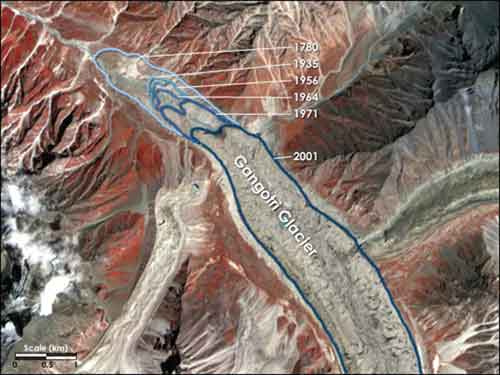
Figure 2: Gangotri Glacier, source of the Ganges, is one of the
largest glaciers in the Himalayas. It has been receding since 1780 and in recent years the pace of retreat has accelerated.
(Image from: NASA Earth Observatory, Jesse Allen).
Full Size Image
In Western China, 25 per cent of the population directly depends on meltwater in the dry season (47); there is
less dependence in monsoon-dominated regions (8).
Despite the key role meltwater plays in people's livelihoods and on the region's ecosystem services, such
factors as annual amounts of ice and snow melt, its seasonal and spatial variability, as well as the contributions of
precipitation to these basins, have not been clearly enumerated (24).
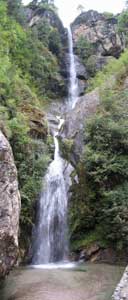
The State of Knowledge
Are the Glaciers Retreating, and If So, is Climate Change the Cause?
Many studies state that the melting of glaciers is a clear indicator of climate change (46, 20) and note that glacier
change is the most visible and obvious indicator of changing temperatures (1, 43). Temperatures at some locations in
the Himalayan region have risen faster than the global average. From 1982 to 2006, the average annual mean temperature
in the region increased by 1.5 °C with an average increase of .06 °C per year, although the rate of warming varies
across seasons and ecoregions (34). It stands to reason that the rising temperature in the Himalayas would affect glacier
melt (3). However, uncertainty about the current state of Himalayan glaciers (4) and the future state of the climate, as well
as an incomplete understanding of the processes affecting Himalayan glaciers under the current climate,
make any projections of climate change's impact on glaciers uncertain as well (2, 23, 17, 39).
Issues related to Himalayan glaciers have become a major focus of public concern and scientific debate (4). In spite of
recent attempts to address the knowledge gaps on the state of Himalayan glaciers, the findings still show inconsistencies,
as illustrated in the following examples:
-
Analyses by Bolch and others (2012) and Gardelle and others (2012) have shown gains in the glaciers of the central
Karakoram region (Figure 3) (4,12), although the complex behaviour of the glaciers is still unclear;
-
Jacob and others (2012) estimated glacial melt to be 4±20 Gigatons (Gt) per year for 2003-2010 (22). This amount
is significantly lower than the estimate of 47±12 Gt per year for 2003-2009 by Matsuo and Heki (2010) in High Mountain
Asia (HMA) (27); both studies used the Gravity Recovery and Climate Change Experiment (GRACE) (1 Gt water is
equivalent to 1 km3);
-
Many glaciologists (30) remain skeptical about the GRACE results (above);
-
Scherler and others (2011) report that 50 per cent of observed heavily debris-covered glaciers in the
westerlies-influenced Karakoram region show advancing or stable conditions (32).
-
Contrary to the aforementioned report, a recent study by Gardelle and others (2012) reveals that high rates of ice loss can
occur on debris-covered glacier tongues (12). Similarly, Bolch and others (2012) noted that the debris-covered area has
increased indicating negative mass balance (4).
Despite inconsistencies in the published research, there is overall agreement that scenarios indicate a
general decrease in ice volumes in HMA (23, 17). Widely-quoted findings from the entire region show that glacier
retreats occurred mostly in the east (4), (Figure 3), 1, 26, 15, 25), while in the west, the glaciers' responses are
complex, especially around the Karakoram region. Since the 1990s, expansion of some larger glaciers has been observed
in the central Karakoram (18, 14); and some have advanced and thickened (12, 32, 7) indicating an apparently atypical
climatic response (23). The current behaviour of Karakoram glaciers prevents drawing conclusions about how the glaciers will
continue to respond in the Karakoram region in the future (28).
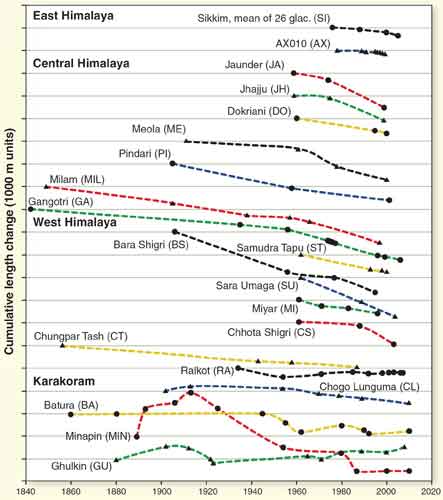
Figure 3: Most of the Himalayan glaciers show retreat since the
mid-19th century, except the glaciers at Nanga Parbat in the northwest (RA, CL) and glaciers in the Karakoram, which
show a complex behaviour (4).
Full Size Image
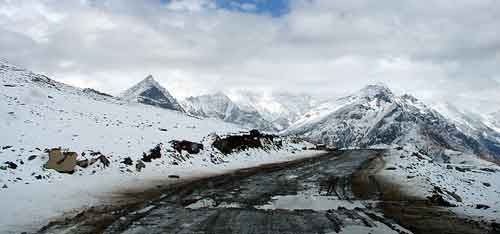
The variability in trends across the entire Himalayan region is because accumulation and ablation patterns are distinctly
uneven (Figure 4). For example, there is accelerated glacier wastage in humid environments but it is suppressed in
arid ones (10). Glaciers within the same climatic zone do not necessarily respond in a similar manner, and exhibit
their own individual behaviour (19). In addition, the environmental setting of the Karakoram is different from the
eastern part of the Himalaya region (Figure 5) — it is colder and its latitude is up to ten degrees farther north
than Nepal (19) (Figure 4). And the western Himalaya and Karakoram lie outside the region dominated by the Indian Monsoon.
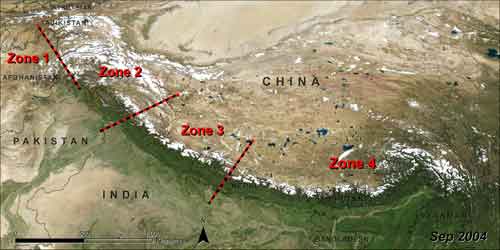
Figure 4: While data are lacking for a good understanding of the
patterns of change in the glaciers of the Himalayas, there are some generalizations that can be made about the different regions
of this vast area. Zone 1: Mainly in Afghanistan, this area has relatively stable or very slowly retreating glaciers.
Zone 2: The Northwestern Himalayas including the Karakoram have highly varied glacier
behaviour, with many surge glaciers, many advancing, stable, and retreating snouts and comparatively few large lakes.
Glaciers in the Pamir Mountains of Tajikistan are generally retreating while further south, behaviour of the
Karakoram glaciers is mixed, but lacking wholesale, rapid disintegration of glacier tongues and rampant
lake growth. Zone 3: Mainly in India, southwestern Tibet and western Nepal, this area has mainly
stagnating, retreating snouts and time variability with periods of slower retreat for some glaciers during parts of the 20th
and 21st centuries. There are fewer lakes than in the eastern Himalayas, but large lakes may be a growing phenomenon as
glaciers thin and tend to stagnate. Zone 4: Mainly Nepal, Bhutan, Sikkim and southeastern Tibet, this area has many large
glacier lakes, especially since the 1960s. Many glaciers are rapidly disintegrating as they stagnate and thin. Glaciers
on the south side generally have more debris cover than they do on the north side (23). Background image from NASA Blue
Marble MODIS
Full Size Image
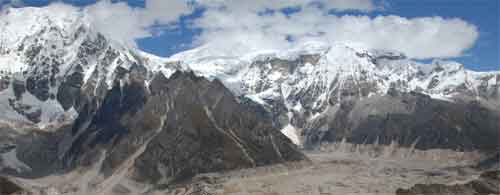
Thothormi Glacier, Bhutan
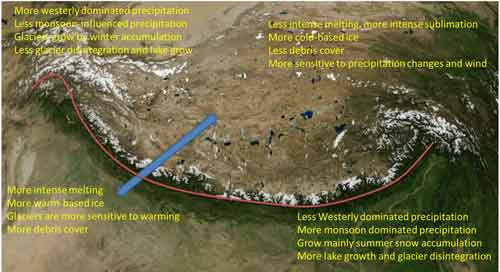
Figure 5: Climatic variations in the Himalaya region. The
climate differs between the east and west and between the north and south, with variations in sources and type of
precipitation and in glacier behaviour and dynamics. There is no sharp dividing line along the 2 000 km-long stretch
between the east and west (1, 23). Background image from ESRI ArcGlobe 10.0.
Full Size Image
Contribution of Glaciers to Hydrology in the Himalayan Basins
There has been no long-term comprehensive in-situ monitoring of glacial melt contributing to the knowledge of
hydrology in the river basins of the Himalayan region. As a result, studies on glacial melt that describe a basin's hydrology
lack direct evidence and sometimes appear to be inconsistent (1, 24). This has led to a change in perception about the level of
threat, and doubts have arisen that melting glaciers provide a key source of water in downstream areas across the entire
Himalayan region. Earlier estimates are now thought to have been far too large and plagued by conflicting results and
inadequate, highly qualitative or simply local-scale evidence. As a result, the situation has been downplayed more recently
as the threat was seen to be less acute than foreseen earlier (1, 17) (see Table 1). Kargel and others (2010) note that
"glaciers are vitally important but widely exaggerated water resources" (23). The numbers of people affected were also
downplayed as reports on the vulnerability of hundreds of millions or billions of people who depend directly on meltwater were
revised to millions of people (23). Some studies, such as the following, even showed that flows into some basins are mostly
driven by precipitation:
-
Runoff due to glacial melt is minor in the wetter monsoon catchments of the Ganges and Brahmaputra but
more substantial in the drier westerly-dominated headwaters of the Indus (17 , 24);
-
In glaciated regions with winter accumulation, where an earlier peak of spring snowmelt is expected, the monsoon-influenced
catchments will maintain peak discharge in summer even with significant reduction in glacier size (17 , 24);
-
Inter-annual runoff variation in the Himalayan glacier catchment is driven more by precipitation than by the mass balance change of glaciers (36);
-
In the Dokriani glacier, winter snowfall has a more pronounced effect on headwater runoff variability
than the variation produced by runoff from a receding glacier (37).
In addition, a widely cited estimate shows considerable variation in the contribution of meltwater across the river
basins fed by Himalayan glaciers (9, 44) (Figure 6), although this varies seasonally and spatially. The importance of meltwater
contribution also varies by basin: it is extremely important to the Indus basin, important for the Brahmaputra basin,
but plays modest roles for the Ganges, Yangtze and Yellow Rivers (17). By region, meltwater contributes 30 per cent to
the total water flow in the eastern Himalayas, 50 per cent in the central and western Himalayas and 80 per cent in
Karakoram (46). Likewise, Rees and Collins (2006) show that if all the Himalayan glaciers were to disappear, there
would be about a 33 per cent reduction in annual mean flow in the west compared to the 1990 level, whereas the
decline in the east would be only about 4-18 per cent (31).
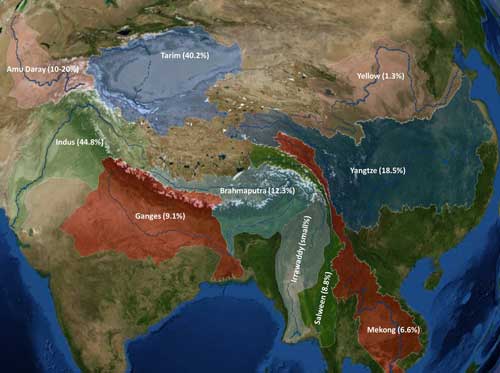
Figure 6: Predicted percentage of glacial melts contributing to
basin flows in the Himalayan basins (Source: predicted percentage flow data from Xu and others 2008 (44). Shape files
superimposed on background image from ESRI ArcGlobe 10.0).
Full Size Image
What Are the Implications?
Scientific assessments and appropriate policy action remain problematic due to significant
uncertainties on glacier changes in the Himalayas. However, available data suggest that the Indus and
Brahmaputra Rivers are most susceptible to flow reductions due to the extent to which climate change is
predicted to affect water availability; in turn, this threatens food security in those regions (Table 1)
(17). For example, the Indus River, which has one of the world's largest irrigation networks, is
Pakistan's primary source of freshwater and can been seen as its lifeline. About 90 per cent of
Pakistan's agriculture depends on the river and much of the world's cotton comes from the Indus River
Valley. On average, about 737 billion gallons of water are being withdrawn from the Indus River
annually to grow cotton (enough water to supply Delhi residents for more than two years). In
addition, the river is used for hydropower generation in Pakistan and India. Glacial melt
contributes as much as half of the region's flow (41, 42). Also, meltwater is crucial for
upstream reservoirs to store and release water to downstream areas when most needed. The
Indus Basin Irrigation System gets its water supply from the Tarbela dam on the Indus
River and the Mangla dam on the Jhelum River, both of which are located in the upper
Indus basin and are fed largely by glacier meltwater. This shows that any change in the
discharge from melting glaciers will have a considerable effect on the millions of people living downstream (17).
An Urgent Need for Appropriate Monitoring
The scientific quality of assessments on the state and trends of Himalayan glaciers relies to a
large extent on the availability of an adequate coverage of long-term and comprehensive data (1). Data and
information on Himalayan glaciers, however, are sparse and lack consistency, multi-temporal recording and
field-validation; thus, rates of change for the entire region are unknown (23, 6). The region has been
known as a "white spot", a term used in the IPCC 2007 Assessment Report to refer to an area for which there
are "little to no data" (40). The IPCC reports also note an urgent need for more information, especially about
water use, the role of altered flow regimes and changes in ice cover, which have been less studied than
temperature effects (20). Also, total glacier behaviour is not systematically monitored. For example, the
complex flow dynamics of glaciers is not yet fully understood, due in large part to their physical
complexity and spatial diversity. The focus has often been on the influence of climate on glaciers to the
neglect of ice dynamics (1). Predicting the behaviour of glaciers is further complicated when they
terminate in glacial melt lakes such as these in Bhutan (Figure 7).
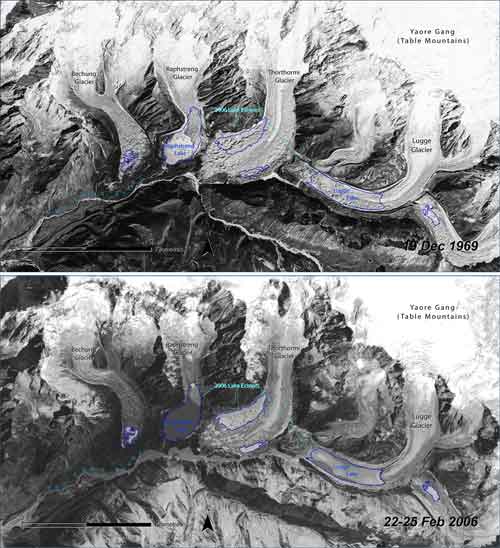
Figure 7: The water can float the terminus releasing it from
the resistance of the land surface and accelerating its flow. The feedback of increased lake levels on the flow rate can
create a positive feedback loop. Rising water levels in glacial lakes can lead to catastrophic floods. The Lunana area shown
above has experienced several such disasters in the past 50 years (21).
Full Size Image
This has constrained in-depth investigation of vulnerability and adaptation to climate change,
which have become central to climate science and policy (35). This is especially the case in attempts to
understand the food, water and energy security implications for the people living in the basins who
depend directly on meltwater, either seasonally or as an overall component of their water budget, and how
they are affected by climate change in their mountainous environment (13).
Although monitoring coverage of Himalayan glaciers is improving, it is not yet sufficient to
fill the knowledge gaps. There are still constraints, such as variable retreat rates, poor glacier
mass-balance data (32) and a lack of systematic long-term in-situ measurement (11). In addition,
available data are not always accessible, especially on transboundary water sharing, often for reasons
"that concern politics and diplomacy rather than science" (29). Available measurements mostly come from
easily accessible glaciers at lower elevations (1); (also see Figure 8 and 9). Out of an estimated 12 000 to
15 000 glaciers in the Himalaya range alone, only a very few have adequate mass-balance data (4, 1).
Thus, experts have recognized the need for greatly increased long-term measurements of glacier mass
balance in the region to build a reliable understanding of the more important long-term trend (23, 1, 39).
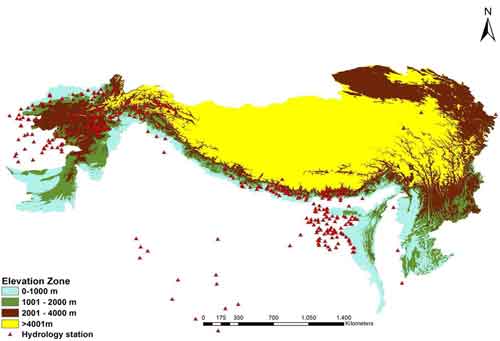
Figure 8: Monitoring stations in the Hindu-Kush Himalayan (HKH) region.
The World Glacier Monitoring Service record shows only 97 monitoring stations in the HKH region in May 2011 (16).
Full Size Image
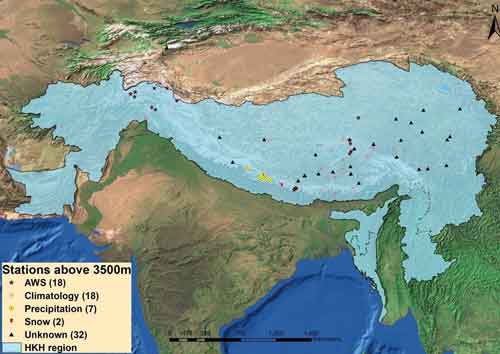
Figure 9: Monitoring stations above 3 500m in HKH region; there are only two snow monitoring stations (16).
Full Size Image
Remaining Challenges for the Himalayan Region
This report shows that scientific studies and evidence are currently
inadequate to assess the status and trends of Himalayan glaciers. This in turn, hampers the development
of future projections on likely impacts on both people and ecosystems, and hinders effective action to
adapt to anticipated changes in the Himalayan region.
This report also notes that a greater focus on glacier assessments in the Himalayas appears to have
led to a tendency to ignore policy-relevant information because of its uncertainty. Hence, effective
communication between the scientific community and policymakers is urgently needed to relay available
knowledge about the potential impacts of changes in glaciers on the region's hydrology and environment
and on the livelihoods of millions of people. More importantly, there is a need to communicate
associated knowledge gaps in a clear and useful way, thus resulting in better decision making.
The region needs more and better monitoring of glaciers and subsequently a state-of-the-science
assessment on glacier change that produces robust scientific findings to better understand the
complexities of those changes and to reduce scientific uncertainty. In particular, transboundary
scientific cooperation is needed to accurately assess regional climate change impacts on Himalayan
glaciers and to fill knowledge gaps by providing scientific findings to the policy community
based on the best scientific understanding of the issues (48, 44, 45).
Acknowledgement
Written by: Janak Pathaka
Production and Outreach Team: Arshia Chanderb, Dipendra Girib, Erick Litswac,
Kim Gieseb, Michelle Anthonyb, Reza Hussainb, Theuri Mwangic
Special thanks to Richard Armstrongc, George Kaserd, Bruce Pengrae, Ron Wittf,
Pascal Peduzzif,Jaap Woerdenf and Jane Barrg for reviewing this bulletin.
(a UNEP GRID Nairobi, b UNEP GRID Sioux Falls, c University of Colorado Boulder,
d University of Innsbruck, e SGT Inc., f UNEP GRID Geneva, g Consultant)
References
1. Armstrong, R.L. (2010). The Glaciers of the Hindu
Kush-Himalayan Region. A summary of the science regarding glacier melt/retreat in the Himalayan, Hindu Kush,
Karakoram, Pamir, and Tien Shan mountain ranges. Technical Paper. Kathmandu. ICIMOD and USAID. ISBN 978 92 9115 173 8
2. Bamber, J. (2012). Climate change: Shrinking glaciers
under scrutiny. Nature 482, 482-483 (23 February 2012). Accessed on 17 April 2012 at
http://www.nature.com/nature/journal/v482/n7386/full/nature10948.html
3. Barnett, T.P., Adam, J.C., Lettenmaier, D.P.
(2005). Potential impacts of a warming climate on water availability in a snow-dominated region. Nature 438(17): 303-309.
4. Bolch, T., Kulkarni, A., Kääb, A., Huggel, C.,
Paul, F., Cogley, J.G., Frey, H., Kargel, J.S., Fujita,
K., Scheel, M., Bajracharya, S and Stoffel, M. (2012). The State and Fate of Himalayan Glaciers. Science 336, 301 (2012).
5. Boos, W.R and Kuang, Z. (2010). Dominant control
of South Asian monsoon by orographic insulation versus plateau heating. Nature, 463, 218-222.
6. Cogley, G. (2011). Present and future states of Himalaya
and Karakoram glaciers. Ann. Glaciol 52(59):68-73.
7. Copland, L., Pope, S., Bishop, M.P., Shroder, J.F., Clendon, P., Bush, A. (2009). Glacier velocities
across central Karakoram. Annual Glaciology. 50, 41-49.
8. Dyurgerov, M.B and Meier, M.F. (2005). Glaciers and the Changing
Earth System: A 2004 Snapshot Occasional
Paper 58. Accessed 13 July 2012 at http://instaar.colorado.edu/other/download/OP58_dyurgerov_meier.pdf
9. Eriksson, M., Xu, J., Shrestha, A.B., Vaidya, R.A., Nepal, S., and Sandstörm, K. (2009). The Changing
Himalayas: Impact of climate change on water resources and livelihoods in the greater Himalayas. Perspectives
on water and climate change adaptation. ICIMOD Kathmandu.
10. Fujita, K and Nuimura, T. (2011). Spatially heterogeneous wastage of Himalayan glaciers. PNAS 108(34):14011-14014.
11. Fujita, K., Thompson, L.G., Ageta, Y., Yasunari, T., Kajikawa, Y., Takeuchi, T. (2006). Thirty-year history of glacier melting in the Nepal Himalayas. Journal of Geophysical Research 111: 6. 2006.
12. Gardelle, J., Berthier, E and Arnaud, Y. (2012). Slight mass gain of Karakoram glacier in the early twenty-first century. Nature Geoscience. Published online 15 April 2012. Accessed on 17 April 2012 at http://www.nature.com/ngeo/journal/vaop/ncurrent/full/ngeo1450.html#/access
13. GWP (2011). Climate Change, Food and Water Security in South Asia: Critical Issues and Cooperative Strategies in an Age of Increased Risk and Uncertainty. Synthesis of Workshop Discussions. A Global Water Partnership (GWP) and International Water Management Institute (IWMI) Workshop, 23-25 February 2011, Colombo, Sri Lanka.
14. Hewitt, K. (2005). The Karakoram anomaly? Glacier expansion and the "elevation effect", Karakoram Himalaya. Mountain Research and Development 25(4): 332-340.
15. ICIMOD (2007). Bajracharya, S.R., Mool, P.K. and Shrestha, B.R. Impact of Climate Change on Himalayan Glaciers and Glacial Lakes. Case Studies on GLOF and Associated Hazard in Nepal and Bhutan. ICIMOD in cooperation with UNEP Regional Office Asia and the Pacific (UNEP/ROAP).
16. ICIMOD (2011). Bajracharya, S.R. Current data gaps and data resources in HKH region. ICIMOD, Kathmandu, Nepal. Presented at "GEOSS support for IPCC assessments". A workshop on the data needs of the climate impacts, adaptation and vulnerability research community. 1-4 Feb 2011, organized by the IPCC and GEO with GCOS, WCRP and IGBP.
17. Immerzeel, W.W., Beek, L.P.H., Bierkens, M.F.P. (2010). Climate Change Will Affect the Asian Water Towers. Science 328, 1382 (2010); DOI: 10.1126/science. 1183188.
18. Immerzeel, W.W., Droogers, P., de Jong, S.M., Bierkens, M.F.P. (2009). Large-scale monitoring of snow cover and runoff simulation in Himalayan river basins using remote sensing. Remote Sensing of Environment 113: 40-49.
19. Inman, M. (2010). Settling the Science on Himalayan glaciers. Nature Report Climate Change. Vol. 4. Macmillan Publisher Limited. Assessed on 22 November 2010 at http://www.nature.com/climate/2010/1003/full/climate.2010.19.html
20. IPCC (2007). Contribution of Working Group II to the Forth Assessment Report of the Intergovernmental Panel on Climate Change, 2007. Accessed on 20 November at 2011 http://www.ipcc.ch/publications_and_data/ar4/wg2/en/contents.html
21. Iwata, S., Karma, Ageta, Y., Sakai, A., Narama, C. and Naito, N. (2004) Glacial geomorphology in the Lunana area in the Bhutan Himalaya: Moraine stages, glacial lakes, and rock glaciers. Himalayan Journal of Sciences 2(4):164-165.
22. Jacob, T., Wahr, J., Pfeffer, W.Tad and Swenson, S. (2012). Recent contribution of glaciers and ice caps to sea level rise. Nature. Letter. Doi:10:1038/nature10847. Accessed on 10 February 2012 at http://www.nature.com/nature/journal/vaop/ncurrent/full/nature10847.html
23. Kargel, J.S., Armstrong, R., Arnaud, Y., Bajracharya, S., Berthier, E., Bishop, M.P., Bolch, T., Bush, A., Cogley, G., Fujita, K., Furfaro, R., Gillespie, A., Haritashya, U., Kaser, G., Singh Khalsa, S.J., Leonard, G., Molnia, B., Racoviteanu, A., Raup, B., Shrestha, B., Shroder, J and Van der Veen, C. (2010). Satellite-era glacier changes in High Asia. Accessed on 23 April at 2012 http://web.hwr.arizona.edu/~gleonard/2009Dec-FallAGU-Soot-PressConference-Backgrounder-Kargel.pdf
24. Kaser, G., Groβhauser, M and Marzeion, B. (2010). Contribution potential of glaciers to water availability in different climate regimes. PANS, Vol. 107, No. 47. 20223-20227.
25. Kayastha, R.B and Harrison, S.P. (2008). Changes of the equilibrium-line altitude since the Little Ice Age in the Nepalese Himalaya. Annals of Glaciology, 48:93-99.
26. Kumar, V., Singh, P and Singh, V. (2007). Snow and Glacier Melt Contribution in the Beas River at Pandoh Dam, Himachal Predesh, India. Hydrological Science Journal, Vol. 52, No. 2, 2007, pp. 376-388.
27. Matsuo, K and Heki, K. (2010). Time-variable ice loss in Asian high mountains from satellite gravimetry. Earth and Planetary Science Latters 290 (2010) 30-36.
28. Perkins, S. (2012). Renegade glaciers gain ice. Nature. 15 April 2012. Accessed on 25 April 2012 at http://www.nature.com/news/renegade-glaciers-gain-ice-1.10448
29. Nature (2011). Climate action a ‘moral responsibility'. Nature spoke with Qin Dahe. Nature. Published online 20 October 2011. Accessed on 25 April 2012 at http://www.nature.com/news/2011/111020/full/news.2011.604.html
30. Qiu, J. (2012). Glaciologists to target third pole. Nature, 484. 19. April 2012. Accessed on 25 April 2012 at http://www.nature.com/news/glaciologists-to-target-third-pole-1.10382
31. Rees, H.G and Collins, D.N. (2006). Regional differences in response of flow in glacier-fed Himalayan Rivers to climate warning. Hydrological Processes 20(10): 2157-2169.
32. Scherler, D., Bookhagen, B and Strecker, M.R. (2011). Spatially variable response of Himalayan glaciers to climate change affected by debris cover. Nature Geoscience. 4, 157-159. March 2011.
33. Sharma, E., Bhuchar, S., Xing, M.A. and Kothyari, B.P. (2007). Land use change and its impact on hydro-ecological linkages in Himalayan watersheds. Tropical Ecology 48(2): 151-161, 2007. International Society for Tropical Ecology.
34. Shrestha, U.B., Gautam, S and Bawa, K.S. (2012). Widespread climate change in the Himalayas and associated changes in local ecosystems. PLoS One 7(5): e36741. Doi:10.1371/journal.pone.0036741. Accessed on 20 June 2012 at http://www.plosone.org/article/info:doi/10.1371/journal.pone.0036741
35. Stigter, C.K and Winarto. Y.T. (2012). What Climate Change Means for Farmers in Asia. Earthzine. 4 April 2012. Accessed on 23 April 2012 at http://www.earthzine.org/2012/04/04/what-climate-change-means-for-farmers-in-asia/
36. Thayyen, R.J and Gergan, J.T. (2010). Role of glaciers in watershed hydrology: Himalayan Catchment. The Cryosphere, 4, 115-128, 2010. Accessed on 02 December 2011 at http://www.the-cryosphere-discuss.net/3/443/2009/tcd-3-443-2009-print.pdf
37. Thayyen, R.J., Gergan, J.T., and Dobhal, D.P. (2007). Role of glaciers and snow cover on headwater river hydrology in monsoon regime – Micro-scale study of Din Gad catchment, Garhwal Himalaya, India. Current Science, Vol. 92, No. 3, 2007.
38. UNEP (2008). Atmospheric Brown Clouds. Regional Assessment Report with Focus on
Asia. Nairobi, Kenya.
39. UNEP (2009). Recent Trends in Melting Glaciers, Tropospheric Temperatures over the Himalayas and Summer Monsoon Rainfall over India. Nairobi. Kenya.
40. USAID (2010). Malone, E.L. Changing glaciers and hydrology in Asia addressing vulnerabilities to glacier melt impacts. Accessed on 24 November 2011 at http://pdf.usaid.gov/pdf_docs/PNADU628.pdf
41. Wheeler, W. (2011). India and Pakistan at odds over shrinking Indus River. Irrigation and hydroelectric projects are draining the river's flow, while glaciers are melting in Kashmir. For National Geographic News. Published October 12, 2011. Accessed 23 November 2011 at http://news.nationalgeographic.com/news/2011/10/111012-india-pakistan-indus-river-water/
42. Winiger, M., Gumpert, M., Yamout, H. (2005). Karakoram-Hindu Kush-Western Himalaya: assessing high-altitude water resources. Hydrological Processes 19(12): 2329-2338.
43. Winkler, S., Chinn, T., Gartner-Roer, I., Nussbaumer, S.U., Zemp, M and Zumbuhl, H.J. (2010). An Introduction to Mountain Glaciers as Climate Indicators with Spatial and Temporal Diversity. Erdkunde. Vol. 64. No. 2. 97-118.
44. Xu, J., Grumbine, R.E., Shrestha, A., Eriksson, M., Yang, X., Wang, Y and Wilkes, A. (2008). The Melting Himalayas: Cascading Effeccts of Climate Change on Water, Biodiversity, and Livelihoods. Conservation Biology, 23 (3), 520-530.
45. Xu, J. (2007). The Highlands: A Shared Water Tower in a Changing Climate and Changing Asia. ICRAF Working Paper. ICRAF China 2007.
46. Xu, J., Shrestha, A and Eriksson, M. (2009). Climate change and its impacts on glaciers and water resource management in the Himalayan Region. Assessment of Snow, Glacier and Water Resources in Asia. International Hydrological Programme of UNESCO and Hydrology and Water Resources Programme of WMO.
47. Xu, J., Shrestha, A., Vaidya, R., Eriksson, M and Hewitt, K. (2007). The Melting Himalayas. Regional Challenges and Local Impacts of Climate Change on Mountain Ecosystems and Livelihoods, ICIMOD Technical Paper, Kathmandu, Nepal.
48. Yao, T.D., Thompson, L.G., Musbrugger, V., Ma, Y.M., Zhang, F., Yang, X.X. and Joswiak, D. (2011). UNESCO-SCOPE-UNEP Policy Briefs Series. Third Pole Environment. June 2011. UNESCO-SCOPE-UNEP, Paris.
If you no longer wish to receive this bulletin you can unsubscribe anytime.
Information is regularly scanned, screened, filtered, carefully edited, and published for educational purposes. UNEP does not accept any liability
or responsibility for the accuracy, completeness, or any other quality of information and data published or linked to the site. Please read our
privacy policy and
disclaimer for further information.
|



















